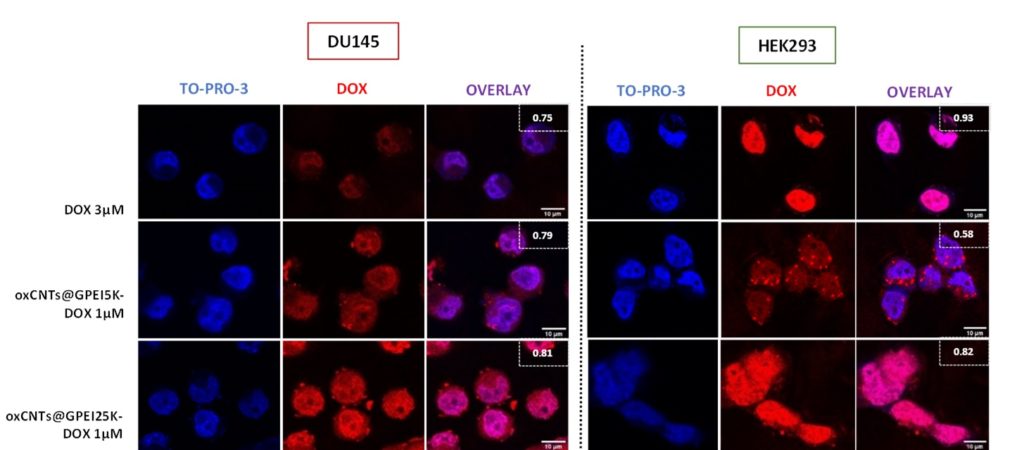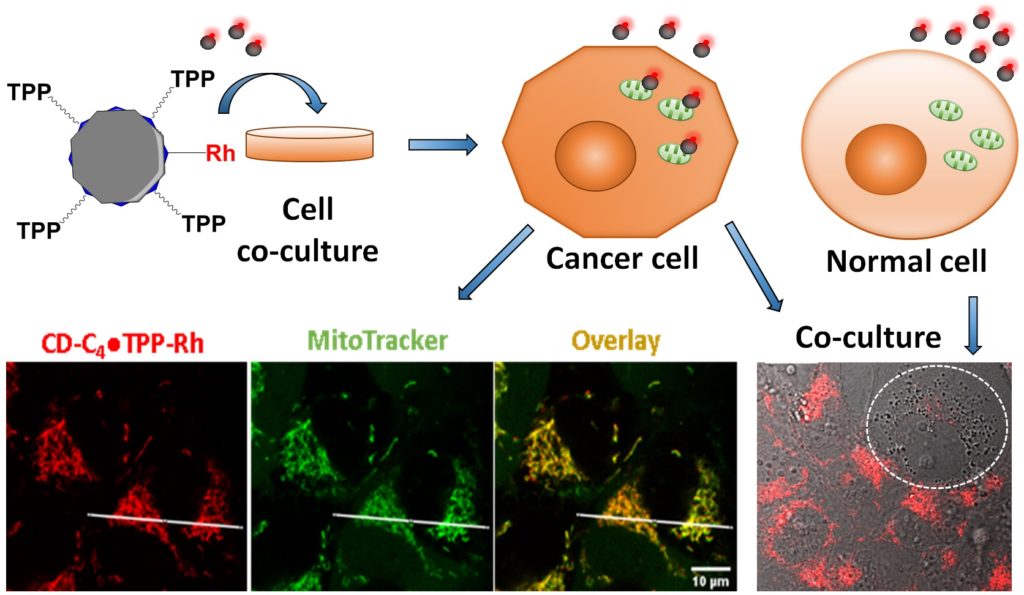Functional carbon-based materials as drug delivery systems or bioimaging agents
Carbon-based nanomaterials modified with functional dendritic polymers were developed.1-3 Specifically, cationic hydrophilic dendritic polymers induce, through appropriate interactions, excellent and stable dispersions of carbon nanotubes and carbon nanodisks in aqueous media. These nanomaterials were physicochemically characterized by a variety of physicochemical methods and subsequently were evaluated as controlled release drug delivery systems.4-6

Additionally, functionalized highly fluorescent carbon dots have been developed and evaluated for mitochondrial subcellular localization and bioimaging agents.7

Selected publications
- T. Tsoufis, F. Katsaros, Z. Sideratou, B. J. Kooi, M. A. Karakassides, A. Siozos, Intercalation study of low molecular weight hyperbranched polyethyleneimine into graphene oxide. Chem. Eur. J. 20, 8129-8137 (2014).
- T. Tsoufis, F. Katsaros, Z. Sideratou, G. Romanos, O. Ivashenko, P. Rudolf, B. J. Kooi, S. Papageorgiou, M. A. Karakassides, Tailor-made graphite oxide–DAB poly(propylene imine) dendrimer intercalated hybrids and their potential for efficient CO2 adsorption. Chem. Commun. 50, 10967-10970 (2014).
- T. Tsoufis, Z. Syrgiannis, N. Akhtar, M. Prato, F. Katsaros, Z. Sideratou, A. Kouloumpis, D. Gournis, and P. Rudolf, In-situ growth of capping-free magnetic iron oxide nanoparticles on liquid-phase exfoliated graphene, Nanoscale 7, 8995-9003 (2015).
- P. Zygouri, T. Tsoufis, A. Kouloumpis, M. Patila, G. Potsi, A.A. Sevastos, Z. Sideratou, F. Katsaros, G. Charalambopoulou, H. Stamatis, P. Rudolf, T.A. Steriotis, D. Gournis, Synthesis, characterization and assessment of hydrophilic oxidized carbon nanodiscs in bio-related applications, RSC Adv. 8, 122-131 (2018). DOI: 10.1039/C7RA11045F.
- P. Zygouri, K. Spyrou, E. Mitsari, M. Barrio, R. Macovez, M. Patila, H. Stamatis, I. I. Verginadis, A.P. Velalopoulou, A.M. Evangelou, Z. Sideratou, D. Gournis, P. Rudolf, A facile approach to hydrophilic oxidized fullerenes and their derivatives as cytotoxic agents and supports for nanobiocatalytic systems. Scientific Reports 10, 8244 (2020). DOI: 10.1038/s41598-020-65117-7.
- K.-M. Lyra, A. Kaminari, K. N. Panagiotaki, K. Spyrou, S. Papageorgiou, E. Sakellis, F. K. Katsaros, Z. Sideratou, Multi-Walled Carbon Nanotubes Decorated with Guanidinylated Dendritic Molecular Transporters: An Efficient Platform for the Selective Anticancer Activity of Doxorubicin. Pharmaceutics 13, 858 (2021). DOI:10.3390/pharmaceutics13060858.
- A. Kaminari, E. Nikoli, A. Athanasopoulos, E. Sakellis, Z. Sideratou, D. Tsiourvas, Engineering Mitochondriotropic Carbon Dots for Targeting Cancer Cells. Pharmaceuticals 14, 932 (2021). DOI: 10.3390/ph14090932.